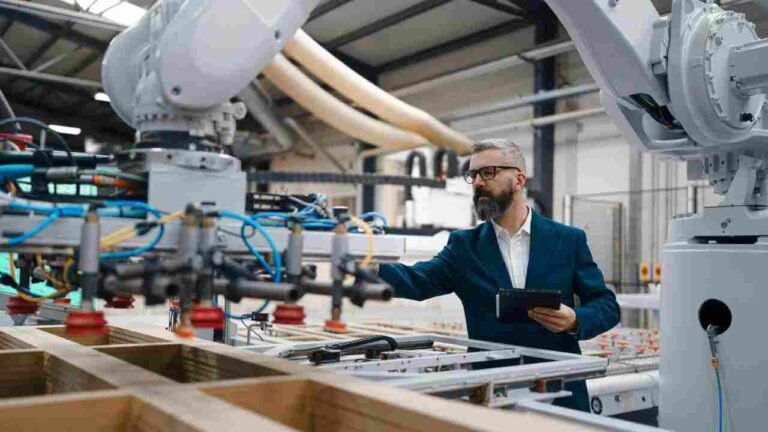1. Robotics and Its Transformative Power in Education
The introduction of robotics in education has brought a new dimension to learning, revolutionizing how students engage with complex subjects. From enhancing STEM education to offering hands-on learning experiences, robotics has become an essential tool in shaping the future of education. Robotics is not just about teaching students how to build robots but also about instilling critical thinking, problem-solving skills, and creativity.
Key Features:
- Hands-on learning experiences
- Encouraging critical thinking and problem-solving
- Enhancing STEM education
2. Robotics as a Tool for Teaching STEM Subjects
One of the most significant contributions of robotics in education is its ability to teach STEM (Science, Technology, Engineering, and Mathematics) concepts in a practical and engaging way. Robots help students grasp abstract STEM principles through real-world applications, turning complex ideas into tangible learning experiences. Whether it’s coding a robot to perform tasks or using robotics kits to explore physics concepts, students develop an understanding of STEM subjects that is more engaging and memorable.
Key Features:
- Practical application of STEM concepts
- Hands-on experiments with robotics kits
- Interactive learning that fosters engagement in STEM fields
3. Encouraging Collaboration and Teamwork
Robotics projects often require students to work in teams, fostering collaboration and teamwork. As students come together to design, build, and program robots, they learn essential skills such as communication, cooperation, and leadership. Collaborative robotics projects not only improve social skills but also help students understand the importance of working together to solve problems.
Key Features:
- Promotes teamwork and collaboration
- Development of social and communication skills
- Encourages cooperative problem-solving in group settings
4. Robotics and Coding: Preparing Students for the Future Workforce
With the increasing demand for tech-savvy professionals, teaching coding and robotics in schools equips students with valuable skills for the future workforce. Robotics encourages coding literacy by allowing students to write algorithms and design programs that control robots. Through learning programming languages such as Python, C++, or Blockly, students gain the foundational skills necessary for careers in technology, engineering, and robotics.
Key Features:
- Exposure to coding and programming languages
- Hands-on experience in building and programming robots
- Preparation for future tech-related careers
5. Personalized Learning and Adaptive Robotics
Robots are also playing a role in personalized learning by adapting to individual student needs. Some educational robots are equipped with AI that allows them to adjust the difficulty of tasks based on a student’s performance. This personalized approach helps students learn at their own pace and ensures they are constantly challenged, keeping them engaged while addressing learning gaps.
Key Features:
- Adaptive learning based on individual progress
- AI-driven personalized learning experiences
- Tailored challenges that meet student needs
6. Enhancing Creativity and Innovation
Robotics in education encourages creativity by allowing students to design and build their robots. These hands-on projects require students to think outside the box, experiment with various components, and find innovative solutions. Robotics stimulates creativity, as students are not just following instructions but creating something new, from concept to execution.
Key Features:
- Encourages innovative thinking and creative problem-solving
- Hands-on design and building of robots
- Opportunity to experiment and iterate on ideas
7. Robotics in Special Education: Promoting Inclusion
Robots are increasingly being used in special education settings, offering students with disabilities unique opportunities to learn and engage. Robotics can be tailored to meet the specific needs of students with autism, physical disabilities, or cognitive challenges. By interacting with robots, these students can improve their motor skills, enhance communication, and participate in learning activities that might otherwise be difficult for them.
Key Features:
- Specially designed robots for students with disabilities
- Promotes interaction and communication for children with autism
- Helps students develop motor and cognitive skills
8. Robotics Competitions and Events: A Platform for Learning and Growth
Robotics competitions, such as FIRST Robotics and VEX Robotics, offer students the chance to apply their learning in a competitive setting. These events encourage students to build and program robots to complete specific tasks, fostering a spirit of innovation and teamwork. Through competitions, students can test their skills, gain confidence, and interact with peers from different schools, creating a global network of young innovators.
Key Features:
- Real-world application of robotics concepts
- Competitive environment that fosters innovation and teamwork
- Opportunities for networking and skill-building through events
9. Robotics and Artificial Intelligence: Exploring the Future
The integration of artificial intelligence (AI) with robotics in education is paving the way for smarter, more intuitive learning experiences. AI-powered robots can interact with students in real time, assess their progress, and provide immediate feedback. These robots can also simulate complex scenarios and engage in adaptive learning strategies, further enhancing the educational experience.
Key Features:
- AI-powered robots that adapt to student needs
- Real-time assessment and feedback on student performance
- Simulated learning experiences using AI technologies
10. The Future of Robotics in Education: A Vision for Tomorrow
Looking ahead, robotics is set to become an even more integral part of education. The future of educational robotics includes fully autonomous robots capable of managing classroom activities, AI tutors that assist with personalized learning, and virtual reality (VR) environments powered by robotics. These advancements will further enhance learning experiences, making education more interactive, immersive, and tailored to individual needs.
Key Features:
- Fully autonomous classroom robots for teaching assistance
- AI-driven personalized tutors for students
- Immersive VR experiences powered by robotics
Conclusion
Robotics is reshaping the education landscape by providing new ways for students to engage with learning. From enhancing STEM education to encouraging creativity and collaboration, robotics offers a transformative learning experience. As technology continues to evolve, the integration of robotics in classrooms will continue to empower students with the skills they need to succeed in the future, making education more interactive, personalized, and inclusive.

